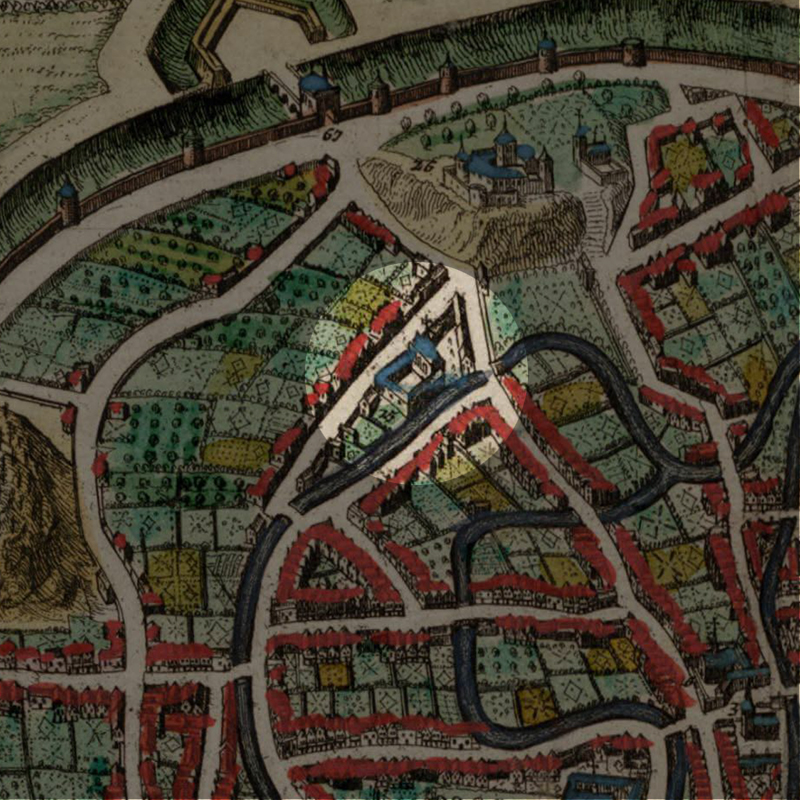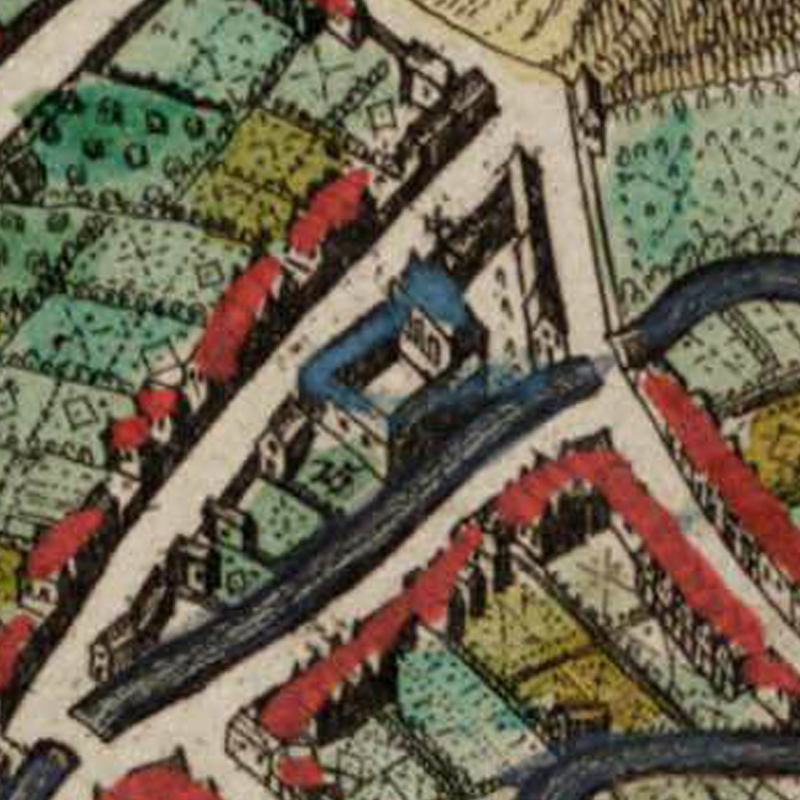ABOUT
The cartographer misnamed the spot #25 as the “Swart Susterhuys” (Zwartzustersklooster) – Convent of the Augustinian “Black” Sisters. It was in fact the site of the Abbey of the Our Lady of the Vineyard (Abdij Onze-Lieve-Vrouw ten Wijngaard) that belonged to the Cistercian Sisters. Also, the spot was misplaced between modern-day Ridderstraat and de Voer river (Fonteinstraat). The right spot was on the other side of the river between the Fonteinstraat and the Mechelesestraat.
Origin
The Abbey of the Our Lady of the Vineyard (Abdij van Onze-Lieve-Vrouw ten Wijngaard) has largely been forgotten by Leuven citizens.
On 30 May 1519, the abbey was officially founded through the instigation of the Abbot of the Sint-Bernardus aan de Schelde in Hemiksem. The founding charter listed as founders: Catharina van Oppendorp (the same rich widow who founded the Clarissenklooster), Mayor Walter van de Tymple and his sons Johan and Lodewijk.
The charter recorded that the city administration imposed four restrictions on the founding on this abbey: One, that it cannot contain more than 30 sisters; Two, the recruits should only be from Leuven; Three, it is not absolved from taxes and lastly, its worldly possessions must be administered by the two registered founded as curators. By 1533, the abbey officially became that of the Cistercian Order.
Why the name?
Forgotten by most Leuven inhabitants, the hills west of the Castle used to be vineyards. Today, the piece of land belongs to De Wijnpers school and the medieval wine press at the foot of the hill is the only building left of this legacy.
The abbey, located right at the foot of the Castle hill, was thus named after the vineyards. It was also known as “Marie Vinea“, and by the 18th century when French became the language of Leuven’s upper class, it was known as “Abbaye de la Vignette“.
Saved by its financial troubles
Not much was known about the abbey except for its financial records and records of the head nuns. It all started with Abbess Anna de Paepe (1629-1663), who had to spend beyond the abbey’s means on building works to deal with the increased number of recruits. This left her successors in terrible financial straits, they virtually had to beg in order to keep the abbey running. Somewhere then, they founded a school for girls, in order to keep the money coming in. It was until Abbess Christina Van der Motten (1728-1735) that the abbey was no longer in the reds.
Due to this school, the abbey actually escaped the Edict of Emperor Jozef II who wanted to dissolve all religious organisations in 1783.
Nonetheless, like many religious institutions in Leuven, the Abdij van Onze-Lieve-Vrouw ten Wijngaard fell to the French invaders during the French Revolution. On 2 June 1798, French revolutionaries drove the 19 sisters from the abbey. They sought refuge in a house along the Vaartstraat, but the community dissolved a year later. The date of the decease of the last abbess was not known.
The very same year, the buildings were torn down and sold off.
What's so special about this place?
An unremarkable place
A plaque, that was still visible in 1796 carried an inscription that summarises the origins of the community:
O Maria Moeder Godts, o Moeder der genade,
Bid Jesum, uwen Soon voor dees die hier is vreugd
Afplanten desen plant, met WYNGAERT, vroeg en spade,
En dat sy met ‘t plantsoen aengroeyen in de deugd.
D’Abdis, die ‘t werck begonst, was MARGARIET VAN YTERE,
d’Eerste Priorin JOSINA VAN MANSDALE alias KELDERMANS,
CATHARINA VAN DER ELST met MAEGARIET DE GRADE,
PHILIPPYN LE FORTE, die nemen eenen pade,
Om met een susterken MARIA CRABBE samen,
Op Sinte-Agathe dag, vyftien hondern negentien,
Verlaten hebb .sde het Clooster Water-Branen,
‘t Beginsel van ‘t plantsoen der wyngaertjens te zien.
Den wyngaert, soo begonst, is groeysaem aengewassen,
Want die maer waren ses syn nu wel vyfmael ses.
Men siet er een en twintig nu naer de coor oppassen,
En negen susterkens tot handwerck meer expres.
Des bidden al gelyck int jaer sestien hondert
Tachentig en twee, dat de eerste, voor den loon
Van hun godvruchtig werck, met ieder in ‘t bezonder,
Die dit vernieuwen, nu verkrygen d’hemelsche Kroon.
The plaque, made in 1682, has been lost and the words were luckily preserved by Pelckmans.
According to historical accounts (Louvain Monumental), the cloister and the church were nothing remarkable. The church, consists of a single nave, had three altars. On one of these, stood a statue of Virgin Mary, carved from a piece of wood which had “the miraculous image of Our Lady of Montaigu“.
In the church, laid the ashes of Jean-Chrysostome Henrique, a famous historian of the Order of the Cistercians, who died in Leuven on 23 December 1652.
The House of Nassau
Not quite related to the Abbey itself, but it is worth noting that the parcel of land opposite the abbey framed by the Mechelsestraat to the west, the current-day Sluispark to the north, the Sluisstraat to the east and the Klein-Begijnhof to the south, used to be the residence of Count Johan II van Nassau-Saarbrücken and his wife Johanna van Loon-Heinsberg. In 1511, it came into the possession of Jacques de Witte and Anne de Witte (another rich widow, this time of Jean vander Royeele, Lord of Nethen). The building later disappeared. But between 1675 and 1740, the Cistercian sisters from Rotselaar, built their refuge house here, right opposite to be close to their Order here in Leuven.
The Tombstone of the First Abbess
According to Edward Van Even in his “Louvain dans le passé et dans le présent” published in 1895, some years before, when digging into the foundations for a new building on the same spot, workers found the tombstone of the first abbess which the demolisher Pierre Gens had left buried earlier in 1798 to not have to deal with it. The inscription wrote:
HIER LEYT BEGRAVAN DIE BEMINDE VROUWE SUSTER MAGRITE VAN YTTRE,
DIE ABDISSE WAS VAN DESEN COVENTE,
DIE STERFT DEN YERSTEN DACH VAN FEBRUARI ANNO XVeXLI.
It is not know what happened to the tombstone thereafter.
From wine to beer
For an abbey named after an alcoholic drink, their affiliation to alcohol did not cease with the French Revolution.
In 1838, the terrain was occupied by the Société des Brasseries Belges, the first beer brewery in Leuven powered by steam. The company also operated a brasserie “after the grand brasseries in London”, called “Brasserie de la Vignette” in honour of the abbey. The Société des Brasseries Belges later fused with another to form the Brouwerij De Dijle in 1936, then a year later, this fused with the now famous brewery Artois. Artois went on to become Stella Artois, now owned by AB InBev.
Very few people still know the history of AB InBev that went back to the unremarkable abbey named after wine.
The brewery site was knocked down in 1964-1967, and the remaining silos were developed into an office complex in 1999-2000.
Current situation
The Director’s House
On Number 201, along the Mechelsestraat, you can still find the house of the director of the “Société des Brasseries Belges”, designed by architect F. Vanderperre. Beside the house (Number 203), it was entrance gate to the former brewery complex.
Pathway
There is a small pathway linking Fonteinstraat and Penitentienenstraat called “La Vignette” as an ode to the Abdij van Onze-Lieve-Vrouw ten Wijngaard.
The Revival of the Leuven White Beer
Kevin Celis lives in the small pathway mentioned above called La Vignette. Out of curiosity as to why his street was in French, he embarked on a research that led him to the story of the forgotten “Brasserie de la Vignette”. Kevin was especially interested in it being the first modern brewery in Belgium, and that it employed steam power.
Spurred by this discovery, Kevin persisted in recovering as much material as possible regarding this brewery. Among what he could salvage as records, much of which was lost to time, he stumbled upon a recipe from 1851 of a white beer (or ‘wheat beer’) that used to be produced by the brewery.
Together with a brewer, Kevin recreated the white beer and makes it available to everyone.
To taste the lost taste of Leuven’s white beer, check out Kevin Celis’ website: www.lavignettelouvain.be
Many thanks to sommelier Tim Somers for the tip! (updated in December 2021)
Brasserie de la Vignette
Today, there is an unremarkable brasserie called “La Vignette” opposite the train station on the east end of the city. It is not known if it is in any way linked to the original Brasserie de la Vignette or is a reference to the Abdij Onze-Lieve-Vrouw ten Wijngaard.
Sources:
https://www.odis.be/hercules/toonOrg.php?taalcode=nl&id=37423
https://de.m.wikipedia.org/wiki/Zisterzienserinnenkloster_La_Vignette
Louvain dans le passé et dans le présent, by Edward van Even, 1895
Louvain monumental ou Description historique et artistique de tous les édifices civils et religieux de la dite ville, by Edward van Even, 1860
https://nl.m.wikipedia.org/wiki/Huis_van_Nassau_(Leuven)
https://inventaris.onroerenderfgoed.be/themas/1038
https://inventaris.onroerenderfgoed.be/erfgoedobjecten/206121
https://inventaris.onroerenderfgoed.be/erfgoedobjecten/306724
HOW IT LOOKS LIKE TODAY
Click on the zoom icon to view the full size.









